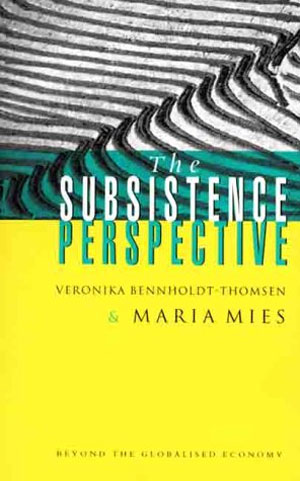by Jeanne Neath
Most people living in the industrialized world feel dependent on the capitalist economy. Most do not realize that the capitalist economy is completely dependent on another economy that is larger and more important than it. This is the subsistence economy.
Maria Mies and Veronika Bennholdt-Thomsen in their book “The Subsistence Perspective” explain that subsistence production includes “all work that is expended in the creation, re-creation and maintenance of immediate life and which has no other purpose.” The aim of subsistence is life!
 Ask yourself, where would industry and Wall Street be if mothers had not borne and nurtured and raised children? (Picture a workforce that wasn’t toilet trained.) How would society function without the countless work that we all do every day that we are not paid for? Some examples of work done within the subsistence economy include: cooking dinner, unpaid caring for children or anyone needing help, home gardening, cleaning your house, walking your dog, pregnancy, giving birth, working with others in community to build a fire break. All these activities take place within the subsistence economy.
Ask yourself, where would industry and Wall Street be if mothers had not borne and nurtured and raised children? (Picture a workforce that wasn’t toilet trained.) How would society function without the countless work that we all do every day that we are not paid for? Some examples of work done within the subsistence economy include: cooking dinner, unpaid caring for children or anyone needing help, home gardening, cleaning your house, walking your dog, pregnancy, giving birth, working with others in community to build a fire break. All these activities take place within the subsistence economy.
Everyone participating in XX Amazons is dependent on both the dominating capitalist economy and on the subsistence economy. Many people in the global South live primarily within a subsistence economy (though the dominating capitalist economy makes their lives increasingly difficult with its theft of “resources”, destruction of land bases and communities).
Margaret Thatcher famously said “There Is No Alternative” to neoliberal capitalism and many believe this still, but Mies and Bennholdt-Thomsen say that “Subsistence Is The Alternative.” Instead of thinking from the perspective of rich or middle class women in the industrialized world, they advocate taking a “view from below”, like that of village women in Bangladesh. They say,
“This means that when we look at reality, when we want to gain clarity about where to go and what to do, we start with the perspective of women, particularly rural women and poor urban women in the South. Further, we start with everyday life and its politics, the strategies of women to keep life going. This view from below enables us to demystify the delusions created by those ‘on top’ that their life and lifestyle are not only the best possible ones but also the image of the future for everybody on this planet. This demystification helps us to see that this so-called good life is possible only for a minority and, moreover, that it is at the expense of others: of nature, of other people, of woman and children.” (p. 3 The Subsistence Perspective)
The good life is actually a life lived from within a subsistence perspective, as Mies and Bennholdt-Thomsen explain:
“The concept ‘subsistence’ is usually associated with poverty and backwardness. In this book, however, we want to show that subsistence not only means hard labour and living at the margins of existence, but also joy in life, happiness and abundance. Such an understanding of subsistence requires that people, particularly women, stop devaluing their own – their own work, their own culture, their own power – and stop expecting the good life to be handed down to them by those ‘on top’. This devaluation of one’s own is, of course, a consequence of forced colonisation and degradation. But it has been internalized by all colonised people, including women. This devalution is futher maintained by the delusion of what we call ‘catch-up development’ and ‘catch-up consumerism’. It is upheld by the promise that eventually all the colonised people at the bottom of the social pyramid will reach the level of those on the top.” (p. 5, The Subsistence Perspective)
Do women (and men) in the industrialized world need to continue with our great dependency on the capitalist economy? Do we have an alternative? Clearly, yes! There is a path open to each of us to increase our participation in the subsistence economy and decrease our participation in the dominating economy. We can do this as individuals and in community. Doing this will be part of the movement toward creating female-centered societies, as Heide Goettner-Abendroth found that the matriarchal societies she studied were based in subsistence (as well as related gift economies).
Resources on the Subsistence Perspective
The Subsistence Perspective: Beyond the Globalized Economy, a radical feminist book by Maria Mies and Veronika Bennholdt-Thomsen
